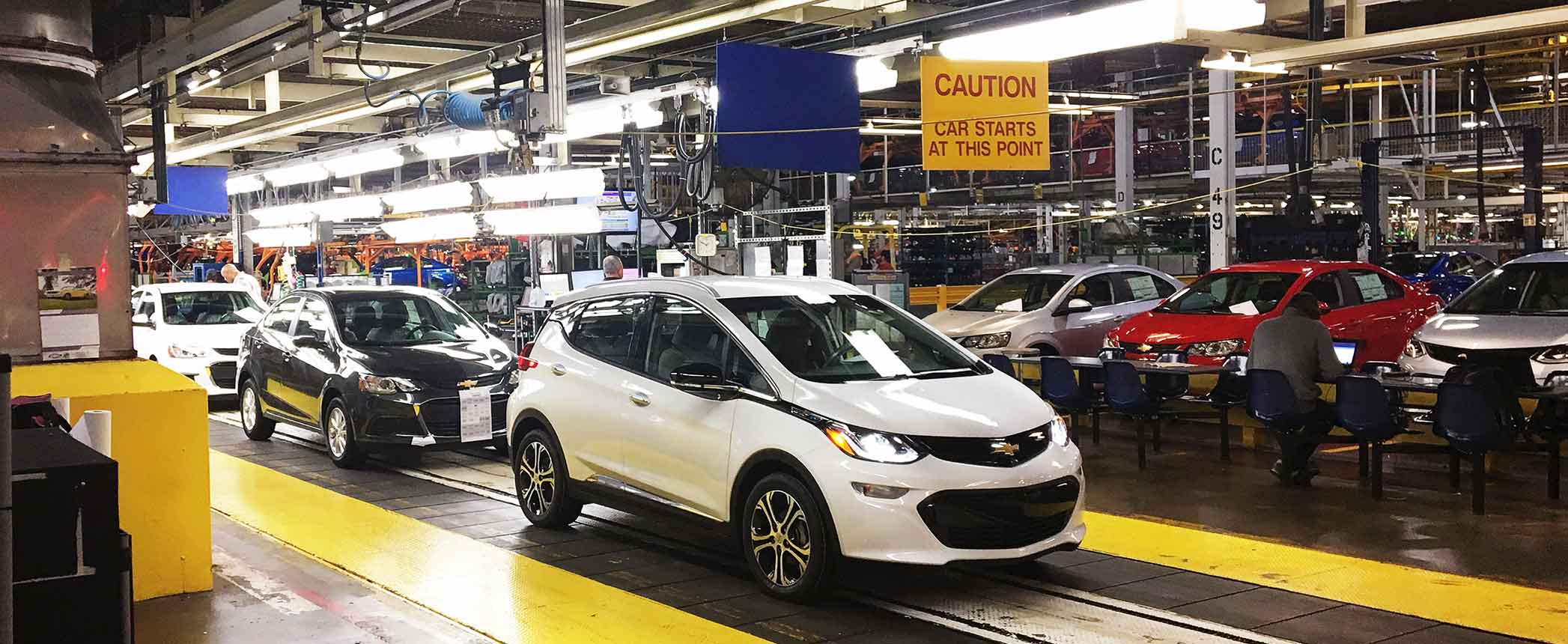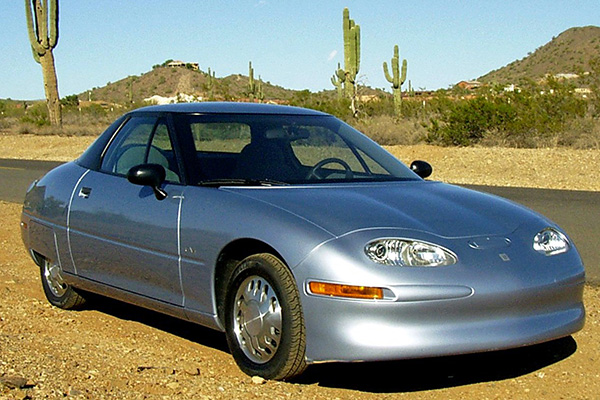
The Detroit car giant hopes the Chevrolet Bolt is no rerun of its failed EV1 experiment in the 1990s.
General Motors launched its first mass-market battery electric vehicle, the Chevrolet Bolt, in late 2016, five years after Japanese rival Nissan’s Leaf. Yet the company already had a profound impact on the development of BEVs today.
It started in 2002, when GM presented its AUTOnomy concept car, a radical vision for the future of transportation. There is more to the 17-year-old concept than meets the eye. The AUTOnomy had a novel type of vehicle architecture that had more in common with a skateboard than it had with a traditional chassis. The car carried fuel cell stacks in the floor, and it was this type of platform, or layout, that later became the blueprint for BEV architectures ranging from those underpinning the Nissan Leaf to the Tesla Model X.
GM, which reported first quarter income of U.S. $2.1 billion in April, is the parent company of Buick, Cadillac, Chevrolet, Corvette and GMC. It sold close to 3 million vehicles worldwide last year. GM also includes Holden in Australia and Baojun in China, a joint venture company with the Shanghai Automotive Industry Corp. Its other Chinese tie-up is truck company FAW-GM.
Baojun offers two BEVs: the E100 and E200 microcars. The E100 was launched in 2017 in the Guangxi Zhuang Autonomous Region. The following year, it was also made available in Qingdao and Shandong. In September 2018, Baojun unveiled the E200. GM’s other BEVs are the Chevrolet-badged Bolt and the Buick Velite 6, which was unveiled at Auto Shanghai in April as a China-only vehicle.
While GM does not release sales data per model, independent sources estimated worldwide sales of the Bolt at some 28,000 units last year, with the E100 and E200 adding another 25,888 units.
While Chevrolet has been leading GM’s EV charge in many parts of the world with the Bolt, it will soon pass the baton to Cadillac, which is to become “the vanguard of the company’s move toward an all-electric future,” said GM. The first Cadillac BEV will be built on GM’s upcoming modular platform for EVs and scheduled for launch in 2021. Another model, known as the BEV3, uses a flexible architecture and is slated for debut the following year, according to GM president Mark Reuss.
Speaking on the sidelines of the North American International Auto Show in January, Reuss said the company was committed to the overhaul of its luxury marque.

“We don’t have any chances left with taking Cadillac to a really new place. This is pretty much it.”
It fits with earlier signs of a big bet on an all-electric future. In 2017, GM’s CEO Mary Barra called electric mobility, autonomous driving and personal mobility solutions the “biggest business opportunity since the creation of the internet,” signaling GM could achieve profitability in those fields by 2021.
At present, GM loses money on its BEVs on offer. In 2017, financial services firm UBS estimated the company had lost $7,400 on each car sold.
BEV3 is an important component of those efforts to achieve EV profitability, as it will help reduce development time. It can be configured in all-, rear- or front-wheel drive and underpin a variety of bodyworks. That does not mean the company’s existing EV architecture will be mothballed. In March, GM announced it would be investing $300 million in its Orion Township manufacturing facility in Michigan for the production of a new Chevrolet BEV.
|
GM aims to launch at least 20 BEVs through 2023, the company said in a statement made in October 2017.
|
The vehicle, one of two new models that will be “based off learnings from the Chevrolet Bolt EV,” will use an upgraded version of the BEV2 platform, the predecessor to the BEV3, and will be offered alongside the Bolt.
In April, a trademark application was filed with the United States Patent and Trademark Office for the name Bolt EUV, a reference to it likely being an electric utility vehicle. This could potentially pit the new car against the likes of the Tesla Model Y. GM aims to launch at least 20 BEVs through 2023, the company said in a statement made in October 2017.
It is anyone’s guess how the U.S. EV market will evolve. Bloomberg New Energy Finance estimates that EVs (both BEVs and plug-in hybrid EVs) will account for 11% of passenger vehicle sales in the U.S. in 2025.
Independent German lubricants supplier Fuchs Petrolub’s base scenario for U.S. BEV sales by 2030 puts their share at 9%, with another 76% of vehicles having some form of electrification, ranging from mild-hybrid systems to plug-in hybrid power trains. Fuchs’ accelerated scenario has the share of BEVs in total U.S. passenger car sales at 21%.
The former is the most likely forecast, as Chief Technology Officer and Executive Board Member Lutz Lindemann told a conference in April that, “no dramatic changes due to e-mobility” are to be expected in the U.S. over the next four to eight years.
The Volkswagen Group takes a longer, more extreme view, and expects BEVs to account for 60% of total car sales in the U.S. in 2040. None of the above might be accurate. In a January 2019 report, Deloitte projected a global oversupply of 14 million EV and plug-in EVs by 2030.
“While there are many variables and unknowns, we do look for certain signposts and watch points in our business, chief among them are government regulation and subsidies, as well as charging infrastructure to keep up with demand,” Luyen Vo, manager of marketing and business development for Chevron Base Oils, told Lubes’n’Greases.
“There are also factors that can challenge or moderate the uptake of BEVs, such as the continued development and fuel economy and emissions improvements of internal combustion engines and how much OEMs continue to invest in ICEs. Our outlook will continue to change and modify accordingly as we measure and monitor all the different variables over time,” said Vo.
For this reason, it is equally difficult to say how the U.S. lubricants market will be affected. According to Fuchs’ estimates, efficiency gains and e-mobility in 2030 will lead to a 20% decline in demand for lubricants in the U.S. compared with 2018 levels. In volume, this would imply a drop in demand from 6.55 million metric tons last year to an estimated 5.24 million tons in 2030.
Chevron remains cautious of providing firm estimates on the impact given all of the changing factors, and so the company’s views are likely to be more conservative to others out there.
“The market won’t only be affected by electric driving, but also by changing consumer behavior as evidenced by increased demand for ride sharing and the interest in autonomous driving technologies,” Vo said.
When GM launched the now legendary EV1 back in 1996, it was advertised with a range of 70 to 90 miles. The first-generation Nissan Leaf was introduced 15 years later yet its EPA range and efficiency rating of 73 miles fell short of that of the EV1. It was not until the 2014 model that the Leaf’s rating was on par. It begs the question, where would GM stand today had it not abandoned electric vehicles at the turn of the century? It took well over a decade for GM to start production on another BEV, the underwhelming Chevrolet Spark EV. It was only offered in California, Oregon and Maryland, with GM eventually selling some 7,400 units. The Spark EV was discontinued at the end of 2016.

Sorry, a technical error occurred and we were unable to log you into your account. We have emailed the problem to our team, and they are looking into the matter. You can reach us at cs@lubesngreases.com.
Click here link to homepage